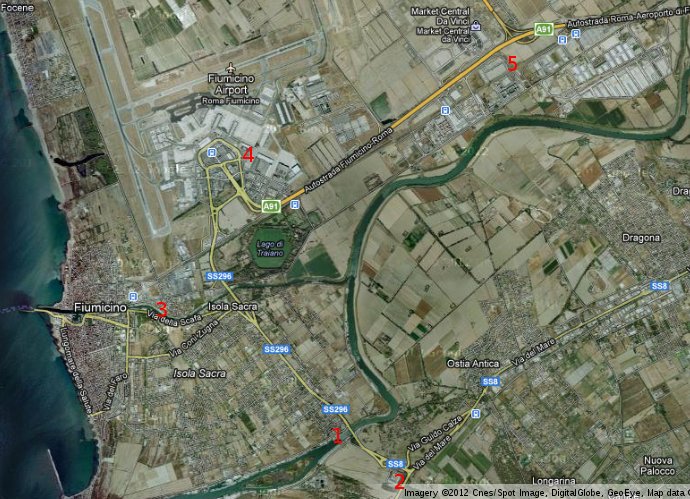(the italian version has many more links)
If they can make you ask the wrong questions, the answers don’t matter. The new Ponte della Scafa (Scafa Bridge) over which Via della Scafa (Scafa Road) crosses the Tiber River is, I think, one of these cases.

This bridge should replace the current, much smaller one (#1 in the picture from Google Maps). Italian newspaper Il Tempo says that this work (that should cost 25 million Euros, but some say 80, 24 meters in width, height about 18 meters) has essentially two advantages:
- much smoother flow of Tiber floods, since thenew bridge wouldn’t have piers in the riverbed as the current one
- No more traffic! “Enough of hours-long traffic jams between Ostia (#2) and Fiumicino (#3) … on one of the most dangerous roads of Italy”, says the press
I don’t know enough to judge the validity of the first reason. As to the second, I’m pretty sure the new bridge is the worst way to solve it. The bridge may be the best answer to the question “How do we make traffic on Via della Scafa smoother?”. That question, however, is much less necessary and interesting than “How do we reduce traffic on Via della Scafa?”
In fact, most of the traffic on the current bridge and on Via della Scafa, that connects the thirteenth Municipality of the City of Rome (#2) to the Fiumicino airport (#4), is local traffic of residents of that Municipality who:
- work in the Fiumicino Airport and are forced to commute by car, even if it’s only a 10⁄12 km distance, because the company buses that once were the norm have been abolished, and there is no public transportation worth considering between the Airport and the thousands of its workers who live just a few km away across the Tiber
- go to the nearby movie theathers and shopping malls (#5), again by car, for the same reason
If the goal were to greatly reduce traffic jams and accidents on Via della Scafa, it would be enough to keep the current bridge and “encourage” all the airport companies and the malls mentioned above to establish (or restore, in the case of the airport) effective private bus services connecting those areas with the XIII Municipality.
This would cost much less than the bridge. Besides, it would save both lots of money (gas is almost 2 Euros/Liter in Italy now) of many airport commuters and, statistically speaking, some cancer and other respiratory diseases to people living close to Via della Scafa.
A bigger bridge, instead, would not reduce traffic at all. It would only make it smoother, but leaving unchanged or maybe even increased just because it would be smoother, the many millions of Euro that the City of Fiumicino makes in fines by their speed limit enforcement cameras.
